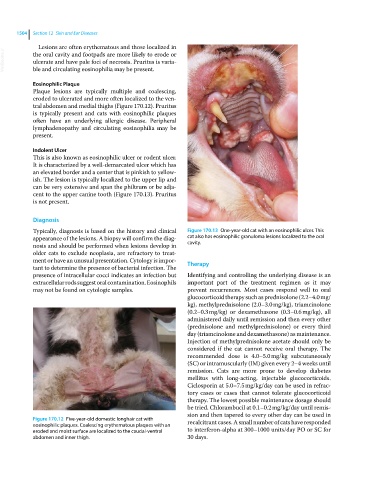Page 1566 - Clinical Small Animal Internal Medicine
P. 1566
1504 Section 12 Skin and Ear Diseases
Lesions are often erythematous and those localized in
VetBooks.ir the oral cavity and footpads are more likely to erode or
ulcerate and have pale foci of necrosis. Pruritus is varia-
ble and circulating eosinophilia may be present.
Eosinophilic Plaque
Plaque lesions are typically multiple and coalescing,
eroded to ulcerated and more often localized to the ven-
tral abdomen and medial thighs (Figure 170.12). Pruritus
is typically present and cats with eosinophilic plaques
often have an underlying allergic disease. Peripheral
lymphadenopathy and circulating eosinophilia may be
present.
Indolent Ulcer
This is also known as eosinophilic ulcer or rodent ulcer.
It is characterized by a well‐demarcated ulcer which has
an elevated border and a center that is pinkish to yellow-
ish. The lesion is typically localized to the upper lip and
can be very extensive and span the philtrum or be adja-
cent to the upper canine tooth (Figure 170.13). Pruritus
is not present.
Diagnosis
Typically, diagnosis is based on the history and clinical Figure 170.13 One‐year‐old cat with an eosinophilic ulcer. This
appearance of the lesions. A biopsy will confirm the diag- cat also has eosinophilic granuloma lesions localized to the oral
nosis and should be performed when lesions develop in cavity.
older cats to exclude neoplasia, are refractory to treat-
ment or have an unusual presentation. Cytology is impor- Therapy
tant to determine the presence of bacterial infection. The
presence of intracellular cocci indicates an infection but Identifying and controlling the underlying disease is an
extracellular rods suggest oral contamination. Eosinophils important part of the treatment regimen as it may
may not be found on cytologic samples. prevent recurrences. Most cases respond well to oral
glucocorticoid therapy such as prednisolone (2.2–4.0 mg/
kg), methylprednisolone (2.0–3.0 mg/kg), triamcinolone
(0.2–0.3 mg/kg) or dexamethasone (0.3–0.6 mg/kg), all
administered daily until remission and then every other
(prednisolone and methylprednisolone) or every third
day (triamcinolone and dexamethasone) as maintenance.
Injection of methylprednisolone acetate should only be
considered if the cat cannot receive oral therapy. The
recommended dose is 4.0–5.0 mg/kg subcutaneously
(SC) or intramuscularly (IM) given every 2–4 weeks until
remission. Cats are more prone to develop diabetes
mellitus with long‐acting, injectable glucocorticoids.
Ciclosporin at 5.0–7.5 mg/kg/day can be used in refrac-
tory cases or cases that cannot tolerate glucocorticoid
therapy. The lowest possible maintenance dosage should
be tried. Chlorambucil at 0.1–0.2 mg/kg/day until remis-
sion and then tapered to every other day can be used in
Figure 170.12 Five‐year‐old domestic longhair cat with recalcitrant cases. A small number of cats have responded
eosinophilic plaques. Coalescing erythematous plaques with an
eroded and moist surface are localized to the caudal‐ventral to interferon‐alpha at 300–1000 units/day PO or SC for
abdomen and inner thigh. 30 days.

